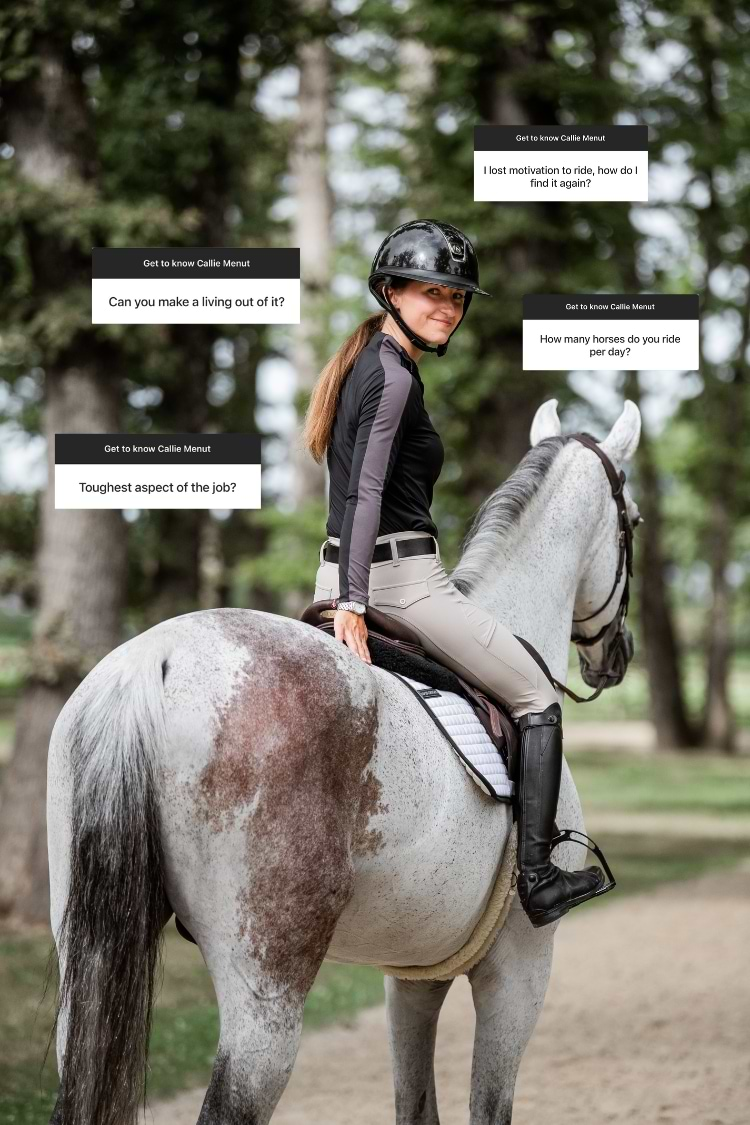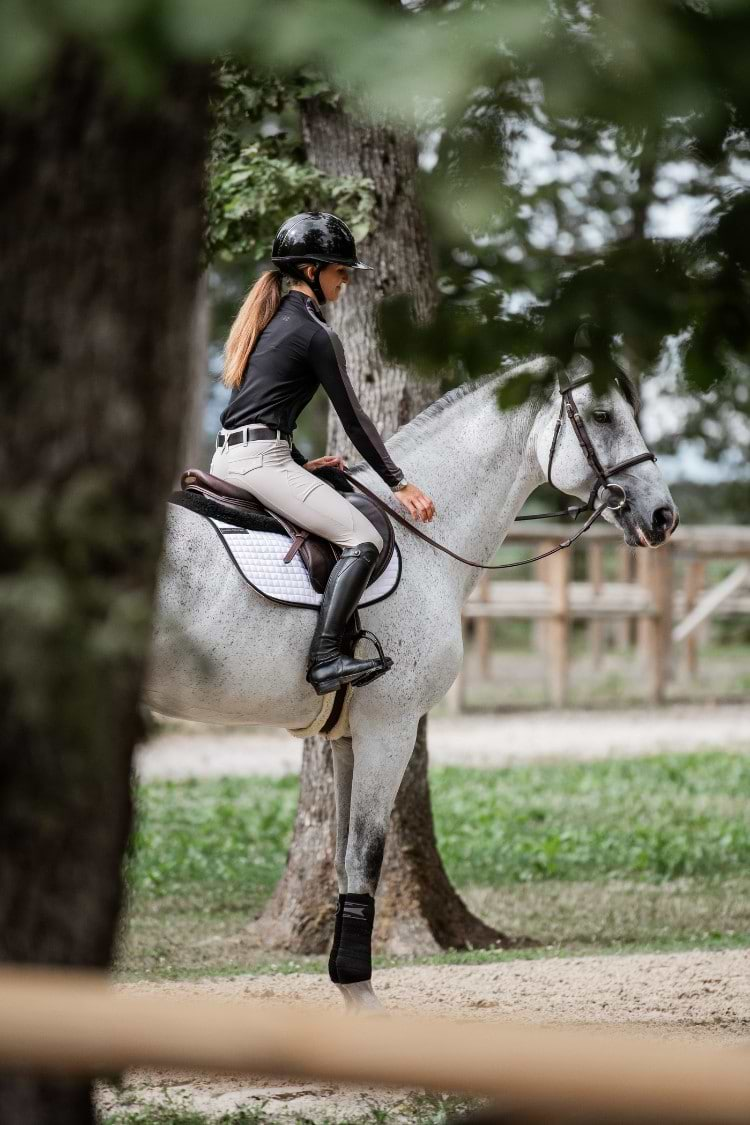Callie Menut Answers:
Q&A with a 5* Flat Rider
In this Q&A, we meet 5* flat rider Callie Menut who shares her exclusive insights. How does one become a flat rider? How did she find her current position? Keep reading for all the deets!
Erika
Sun 27 Aug - 23

Callie Menut Answers:
Q&A with a 5* Flat Rider
In this Q&A, we meet 5* flat rider Callie Menut who shares her exclusive insights. How does one become a flat rider? How did she find her current position? Keep reading for all the deets!
Erika
Sun 27 Aug - 23
Some time ago, we reached out to our community and asked you guys what questions you’d love to ask a professional flat rider if you ever got the chance. Then, we let a true pro answer them: Step into the fascinating world of professional 5* flat rider Callie Menut from Switzerland. In this exclusive Q&A session, she provides unique insights into the life of a flat rider and shares valuable tips for those interested in this profession. Read on to find out more!
💡 What is a flat rider?
Professional riders frequently compete with multiple horses, making it impractical for them to personally train each one. This is where flat riders play a crucial role: A flat rider is a person responsible for training horses on behalf of professional riders, primarily within their stable environment. They don't participate in shows with the horses themselves, but they handle the training and development work behind the scenes, right at the stable.
Let’s begin!
Callie, what’s the difference between a flat rider and groom?
– A flat rider will basically spend their days riding whereas a groom will focus on the caring aspect of the horse and equipment.
Why did you choose to become a flat rider and not a professional rider?
– To be honest, riding in the ring myself was always my dream and it’s still one of my long-term goals! But it is thanks to having good basic flatwork that I was able to get jobs at high-level stables. I chose to use my strengths to get my foot in the door and spend as much time as possible riding good horses, with good people around me. I believe that’s a nice way to improve!
What do you wish you knew before you started as a flat rider?
– I got into it with no real expectations, just with stars in my eyes that people trusted me to ride their horses. Of course, it depends on the stable, but as a flat rider, you should know that you have to communicate a lot. You will be riding the horses at home, while the show rider is at the show or at work, and the show groom will more often than not be at the show too. So, you need to let them know your feelings about the horses and make a good plan to have the horses mentally and physically ready to compete!
Most important quality as a flat rider?
– Well, it might sound obvious, but you need to know your flatwork. You should also be able to adapt to each horse and each rider. The horses should feel good in their mind and body, have enough fitness and rideability. Watch videos of your horses jumping at shows and speak to your rider to know what aspects you can work on at home.
Toughest aspect of the job?
– Not being in the ring, haha! Jokes aside, I personally struggle with the constant “remise en question”, always thinking about what is working or not. When horses don’t develop as you thought they would or when results don’t follow, you will ask yourself 10 000 questions on what you can change or improve. There are many factors involved, so change only one thing at a time, otherwise you will not know what works or doesn’t.
What do you like most about your job?
– I love being on a horse, my body and mind just relax and focus on the present moment. I love seeing the horses in my care feeling and looking good, and love making the best possible routine for them. And I am quite competitive, so I enjoy seeing them do well at shows!

How many horses do you ride per day/week?
– Usually between six to nine horses per day.
Can you make a living out of it?
– Yes. Although, when I get on the first horse between 06:00 and 07:00 on a warm sunny day, and go on the gallop track, I really wonder how I got so lucky that this is actually my job!
Do you just ride or also feed/clean/muck out?
– I focus on riding, but we are a small team and help each other when needed. Mucking out can be a very good time to think!
What does an average day look like?
05:45: I get up, I am a morning person and like to get emails and paperwork done so that I can then focus on riding without being on the phone too much. Breakfast is also a must!
07:00-13:00: I will prepare my first horse and start riding. The evening before, I make a plan for each horse and write it down so that the grooms can have them ready, if they have time.
13:00-15:00: I go ride my horses and have a quick lunch.
15:00-18:00: I usually have one to two horses to ride and then I can focus on the “stable managing” aspect of my job, which is quite demanding and involves other responsibilities. Which I like!
...but this is the theory. As in many stables, we often work longer hours as there are often unforeseen things happening.
How did you find your current job?
– Finding a job is all about being in the right place at the right time, but it’s also thanks to contacts and past experiences in different stables. I have known the Larocca family for many years now, we live in the same area, and I had helped them 10 years ago while I was still at school in Geneva, during my holidays. My mom Karen Stevenson has also trained the Larocca children for many years.
I’ve lost motivation to ride, how do I find it again?
– There was actually a period of time where I wanted to stop riding. You should try to analyze why you are feeling this way. Personally, I love writing things down and making lists! Try to see what makes you happy or bothers you and why you started riding. Is it the riding itself that’s making you feel unmotivated? Or are there other factors, like the people you see at your stable? The atmosphere? Your confidence or tiredness? Understanding where this feeling is coming from will give you clearer answers on what to do next. And sometimes, just taking a step back and spending time with your horse is the best remedy!
What do you do to stay fit and flexible besides riding?
– Riding all these powerful horses keeps you quite fit already! If I feel like I’m not getting enough exercise, I do enjoy running or hiking, even if I do it to clear my mind rather than to gain fitness. Flexibility... is something I need to work on. I do stretch sometimes but I struggle to have it as a real part of my routine.
Do any of your horses have problems with low energy? In that case, what do you do about it?
– First of all, I would check with the vet and do a blood test to be sure there is nothing physically bothering him. After that, I would adapt the feed and supplements – your vet or nutritionist will help you find the best diet for your horse.
– As a riding tip, we need to be careful not to “carry” our horses with our legs. If you are always squeezing your horse, you will lose your balance forward and he will be behind your leg. Try pulling your legs down, and touching your horse lightly with your legs. Every horse feels a fly touching their skin, so they also feel your legs, they just need to know what it means. You could do a weekly plan and introduce more hack/forest work or gallop track. Variation is very important for the general fitness and soundness of your horse, but also for keeping his morale up. Try finding something that your horse enjoys! Just like school, some kids are not so motivated to go, until they find a nice teacher who thought of a fun way to learn and practice.
My horse is injured, any tips on how to deal mentally with this setback?
– Well, horses are “emotional sponges”, so keep in mind that you have a responsibility to him – keeping his moral up is important, so you should keep yours up as well. Having said that, everybody who loves horses will be affected by their horse’s injury, of course. Patience and planning go hand in hand – make a plan with your vet to monitor the progress. This will give you a timeline that will help you set small goals that keep both of you motivated!
Callie, thank you for your time and for answering our community’s questions!
